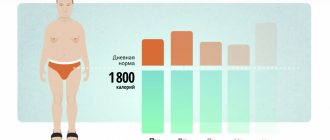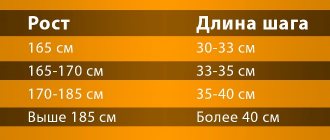In fact, losing weight is much easier than it seems. However, maintaining the achieved results and maintaining a stable weight is where the difficulty typical for many lies. Ultimately, a slim figure requires monitoring your food intake and regular exercise.
Plus, the weight loss strategy should be based on realistic expectations - no matter how much you want, it is impossible to lose 20 kg in a week. Below in the material we will talk about what you need to do to lose 1 kg in a week - and why experts consider this figure to be as safe as possible.
Fat and the human body: why is it important to know how many calories are in a kilogram of fat?
Fat deposits in the body protect internal organs from mechanical stress and keep the body in good condition for a long time in the absence of sufficient nutrition. They also help you recover from illness.
However, it is necessary to control the amount of fat. Otherwise, exceeding the norm will become harmful to life processes:
- hormonal imbalance;
- Internal organs with a high fat content work at full capacity;
- emphasis on joints, blood vessels;
- In addition, it is worth paying attention to the risks associated with serious diseases.
This is why it is so important to monitor current data on body fat, so it is necessary to study how many calories are in 1 kg of human fat and how to properly get rid of excess.
How many calories do you need to burn per day to lose weight?
The fight against extra centimeters is not easy; to win you will need a lot of strength and will.
And only those who went straight to achieving their dreams will be able to achieve a positive result. Often, if a woman was overweight, she justified it not with her weak will, but with some kind of health problems, genetic predisposition, rampant hormones - whatever. After all, sometimes it is difficult to admit that the culprit is simple laziness.
So how many calories do you need to burn to get rid of 1 kg of fat?
How many calories do you need to burn per day to lose 1 kg of fat?
It is believed that to burn 1 kg of fat you need to spend 7700 kcal. Nutritionists advise losing weight by 2-4 kg per month (due to fat). Accordingly, in order to safely lose 0.5 kg of fat per week for the body (keep in mind that the plumb line will be slightly larger due to lost water, muscles, etc.), you need to create a calorie deficit of 3850 kcal per week, which is 550 kcal per day (3850:7).
This is exactly the calorie deficit that needs to be created in order to remove 2 kg of fat per month.
You cannot lose weight by cutting down your diet alone. You must eat properly and balanced. Therefore, it is necessary to achieve a calorie deficit in a comprehensive manner: by reducing calorie intake and by increasing physical activity. With an active lifestyle, your metabolism speeds up and your body burns calories faster during everyday activities.
All this is possible if you go through all the steps presented below.
Formulating a goal
The main thing you need is to formulate a goal. To start, make a list of what losing weight will bring you. For example, it could be a dress, a variety of outfits, dates with handsome men, a healthy body. Also make a list of the reasons that could prevent you from achieving this goal.
These points include softness, weakness of will, and lack of character. If you keep these two lists in front of you constantly and compare the obstacles and possible results, you will undoubtedly overcome all obstacles.
Psychological attitude towards losing weight
Once you realize your weaknesses, you will understand what to do next. The more specific you are about your obstacles, the more likely you are to overcome them. For example, weak will. There is no such thing as a weak will “in principle,” but it can be weak in relation to something. For example, for sweets or training. Which exit? Strengthen it by developing new habits. Make a promise to yourself to give up sugar and confectionery for a week or do the minimum possible workout. Keep your promise and you'll feel completely different at the end of the week. Work according to this principle with all your weaknesses.
Calculation of safe minimum calories
Let's not forget that calories are simply necessary to maintain the vital functions of our body, namely: for the functioning of the cardiovascular system, for the respiratory, endocrine, excretory, etc. And in complete rest, our body burns calories. Now let's talk about the safe minimum calories per day.
How many calories are in 1 kg of fat?
First, it’s worth determining the composition of human fat:
- Lipids in an amount from 54% to 85% of the total mass;
- Water;
- proteins;
- enzymes.
If we talk about how many calories are in 1 gram of fat in its pure form, then it contains about 9 kilocalories. 1 kg of fat contains approximately 7.7 kcal. However, deposits in their pure form are not found in the human body, so the calorie content will be less. The exact value depends on the specific fat composition, which is determined by the characteristics of the organism in question. The average number of calories is 6.5 kcal.
Causes of excess weight
It is important to understand that food can have different composition and calorie content, so in no case can it be classified into one category. Modern food products allow people to choose from dozens of types of “fuel” a suitable option that will not harm the body, but will still allow them to get the right amount of energy for the whole day.
The key property of food is its calorie content. The term refers to the amount of energy obtained by the body through metabolism
Also, special attention is paid to the composition, because
All food products consist of three components:
- Belkov.
- Carbohydrates.
- Zhirov.
If the caloric content of consumed foods exceeds the norm required for the body, this contributes to the deposition of “spare” fuel, which is subcutaneous fat. Naturally, one-time “overdoing” will not cause obesity, but if the abuse becomes systematic, it will lead to a lot of troubles, including the formation of a fat layer on the sides and abdomen.
httpv://www.youtube.com/watch?v=embed/3SvpCd3iBFI
People interested in the number of kcal in 1 kg of human fat should know that this figure is 7716 kcal. That is, gaining one kilogram of excess weight is possible only if you consume 7716 kcal above the required diet. In most cases, this process takes a long time, which explains the gradual and invisible accumulation of fat.
How many calories will you need to burn to lose a pound of fat?
Having determined how many calories are in a person’s fat and having discovered excess fat in the body, proceed to the procedure for achieving the norm. Knowing your body's natural processes will allow you to lose weight more effectively.
In order to lose weight, you need to monitor the lack of calories. It will be necessary to ensure that the amount burned is less than what a person receives from the daily diet. If you need to lose a pound of fat, you will need to achieve a 7,000 calorie deficit. Therefore, to lose a certain amount of weight in a week, you need to create a deficit of 1 thousand calories daily.
For example, if your daily menu is 2.9 kcal, you must eliminate foods from your diet to reach 1.9 kcal.
How to count calories
You can use websites and apps with ready-made recipes. You just need to follow the exact proportions and quantities of ingredients.
Edalite.ru
On this site you will find detailed recipes with photographs. At the end of each, the calorie content and content of proteins, fats, carbohydrates and dietary fiber are indicated.
Edalite.ru →.
YumNymra
There are quite a lot of recipes on the site. There are filters “Low-calorie”, “Fast”, “Simple”. Calories and nutrient composition are listed in the table. If you change the amount of ingredients, you can click on the “Calculate calories” button and find out how many calories there will be in the dish.
“YumNyamra” →
My healthy diet
On this site, all products and recipes are discussed in detail. Below the recipes the calorie content, amount of proteins, fats and carbohydrates are indicated. Below the products there is a description of the vitamins and microelements they contain.
“My healthy diet” →
Calorie counter from FatSecret
In this application you can keep a food diary. Add the foods you have eaten, and the utility will calculate calories and nutritional value. There are ready-made meals and products from different brands. It is even possible to read the barcode of a product.
The app also includes an exercise diary. You can find out how many calories you spend on different types of physical activity.
By the way, the FatSecret service is also available on a PC, if it is more convenient for someone to count calories and activity there.
appbox fallback https://apps.apple.com/ru/app/364140848
YAZIO
In this application, you can select products from the database or scan a barcode, use recipes from the application or create your own.
There is also a calorie burn counter. And if you connect Google Fit, your workouts will be automatically loaded into the application.
MyFitnessPal
This calorie counter allows you to save your recipes, meals, and even entire meals to save time.
There is also an activity counter with cardio and strength exercises. However, the latter do not count calories. You can use this feature to quickly see what you did in your last workout. If you want to count the calories spent on weight training, add a new activity and enter the calories manually.
The counter can be synced with fitness trackers or activity tracking apps MapMyFitness, MapMyRun, Garmin Connect and others.
Source
How are fat cells broken down?
Regardless of how many kilocalories there are in 1 kg of human fat, the peculiarities of fat breakdown should be taken into account. The procedure is performed in the following order:
- To start this process, you first need to reduce the level of fatty acids in the blood through diet, supported by exercise, to increase the concentration of waste products. The latter are responsible for the amount of energy and need fatty acids to replenish them.
- Once in the bloodstream, fatty acids mix with proteins and albumin. The volume of these components determines blood viscosity and albumin values. This is another indicator that is important to monitor when losing weight quickly.
- Acids are used to replenish energy resources used up during vigorous exercise, which helps reduce the amount of fat in the body.
Important: If weight loss is done too quickly, the activity can seriously tax the cardiovascular system and, as a result, the kidneys. Therefore, it is important to lose weight gradually.
It is also important to remember that getting rid of extra pounds by losing weight alone, without exercise, can cause complications. For example, in the absence of active exercise, losing weight can lead to an increase in fatty acids in the body, which contributes to the formation of cholesterol in the blood vessels. If muscle tissue does not burn fat, it can also affect the liver, overloading it. This can lead to cirrhosis of the liver.
Therefore, understanding how many calories are in one gram of fat is not enough to get a comprehensive answer to questions related to effective weight loss.
Norm of carbohydrates per 1 kg of weight
Some people believe that if they consume fat in large quantities, their body weight will increase rapidly. However, such a statement is a big misconception, since fats are vital for the human body for the normal functioning of all internal systems and cells.
All fats that exist in nature today are divided into two groups - unsaturated and saturated. The belonging of an element to one category or another can be determined using the ratio of glycerol and fatty acids included in the products. For the body to function normally, it must be provided with three main polyunsaturated fatty acids:
- Omega-3;
- Omega-6;
- Omega-9.
Note! Products such as vegetable oils (almond, olive), sea fish and pumpkin seeds differ in the content of the three above acids.
All fats are divided into two groups - unsaturated and saturated.
A strictly defined amount of saturated fat helps fill the human body with energy reserves
But the preparation of a diet must be approached with all responsibility and caution, since saturated fats in large quantities increase blood cholesterol levels
As for the recommended daily intake of fat for the male half of humanity, it is at least 2 g per kilogram of weight, and for girls - 1-1.5 g. Older people should consume about 75 g of fat per day. Due to insufficient amounts of lipids, the functioning of the central nervous system is disrupted, general immunity is reduced, and intestinal diseases actively develop.
The amount of fat for people of different ages and gender is also different.
Carbohydrates are the main component that should be included in a person’s daily diet. The energy reserves expended by the human body during the day must be replenished with complex and simple carbohydrates, as well as in the process of burning fats and proteins. When drawing up the daily intake of carbohydrates, you need to remember that it must be equal to the amount of lipids consumed. As for the average daily intake of carbohydrates in the diet, it should be no more than 500 g per day.
How to lose weight correctly?
To get rid of pounds of fat under the skin and around organs without losing muscle mass, you need to consider the consequences of your activities. After all, exercise and diet can not only get rid of fat deposits, but can also cause the loss of necessary muscle mass.
To do this, you should follow a number of recommendations:
- Having determined how many calories are contained in 1 kg of fat, you should also calculate the amount of protein in your diet. This has a lot to do with the effectiveness of weight loss. Typically this value ranges from 10% to 35%. High amounts of protein reduce the risk of muscle loss and increase the likelihood of gaining muscle mass from exercise. Therefore, during the diet it is necessary to introduce foods high in protein into the menu.
- Sleeping regiment. This is important for both a healthy person and an overweight person. It is important to sleep at least 8 hours, and it is better to go to bed before midnight. Chronic lack of sleep can cause malaise, overeating, laziness and slower hormone production;
- physical activity. There is no need to spend hours in the gym in your free time. It is enough to approach the creation of exercises correctly, which will allow you to avoid wasting time and achieve the desired effect. Particular attention should be paid to cardio, adding strength training to regular physical activity. If you do not have the opportunity to perform such exercises, you can use yoga or Pilates - with their help you can also engage and develop the necessary muscle groups;
- Make sure dietary requirements are met. Within a few days of starting the weight loss process, the human body tends to adapt to less weight, which causes a slowdown in metabolic processes, which reduces the effectiveness of the activities performed. Therefore, it is necessary to change your training plan every two weeks.
Knowing how many calories are in a kilogram of fat for a person will not relieve him of excess weight. In addition, a person should familiarize himself with the recommendations of doctors and also monitor their compliance.
What workouts might be suitable?
When you burn calories through physical activity, there are a number of factors that can affect your performance:
- Age;
- current height and weight;
- presence or absence of health problems;
- Normal physical activity;
- diet.
Exercises and their duration should be chosen taking into account the above points. As for measures to lose excess weight, we can highlight:
- jogging in the morning or evening - at least 20 minutes;
- Jumping rope - from 10 minutes;
- swimming - from 15 minutes crawling;
- fitness - 30-40 minutes of moderate intensity exercise.
You should try to make more moves around the house. If it is not possible to move during the day at a given pace, you need to spend more time walking in the fresh air.
Any activity is useful for people who have found out how many calories are in 1 gram of fat and want to achieve standard values for this indicator.
How to stick to a diet correctly?
In the future, having learned how many calories are in one kilogram of fat and how to get rid of excess weight, it will be necessary to clarify the specifics of losing weight with food. You won't be able to get results without changing the menu. The diet should be structured in accordance with the recommendations of nutritionists:
- You need to eat food slowly, since the stomach also needs a lot of energy to digest incoming food. It is important to chew each piece of food thoroughly and take your time. It is better not to be distracted by various irritants such as a smartphone, laptop or TV;
- compliance with the drinking regime. This applies separately to summer time. Often take chilled liquids. Depending on the specific diet rules, you may be allowed to consume frozen juice or frozen berry sorbet;
- When preparing breakfast, keep in mind that your morning meal should consist of complex carbohydrates and fiber. Foods with this composition take longer to be digested by the body, which requires burning more calories;
- you don't need to critically limit your diet. Yes, you can lose weight this way in a short period of time, but this approach will not give long-term results. High risk of negative effects on the human body. Therefore, preference should be given to minor changes in menus and habits - both at home and at work.
Metabolic speed and daily routine are individual for each person, so nutritionists recommend first reducing your daily diet by 300 kilocalories. It is also necessary, before starting the process of losing weight, to consult a doctor who will help explain how many kcal are in 1 kg of human fat and what rules must be followed to achieve the desired result.
IMPORTANT: this article is for informational purposes only! Before use, you should consult a specialist.
Calculation of maintenance level of energy consumption
The amount of energy that the body expends in a state of complete calm is called the basal level of energy expenditure or simply BUE. It can be easily calculated using elementary formulas. With their help, you can determine how much energy the body needs to maintain basic vital functions and an optimal level of functioning.
First of all, you need to know exactly your height in centimeters, weight in kilograms, and you will also need your age. The formulas for highlighting are slightly different for representatives of both sexes:
- men: BUE = 66.5 (13.8* weight) (5.0*height) - (6.8*age)
- women: BUE = 655.1 (9.6*weight) (1.9*height) - (4.7*age)
» alt=»»>
httpv://www.youtube.com/watch?v=embed/SWATV8EYD0Q
For example, following the formula, for a man aged thirty, who is 180 centimeters tall and weighs 100 kilograms, the basal level of energy expenditure will be approximately 2140 kcal (that is, this is exactly the amount of energy the body needs in a state of absolute rest).
Energy that goes into digesting food:
- proteins – total calories multiplied by 0.25
- carbohydrates – total calories multiplied by 0.04-0.06
- fats – the total number of calories also multiplied by 0.04-0.06
Approximate activity during the day:
- walking – 0.079 kcal per kilogram of weight per minute
- sedentary work (office) – 0.028 kcal per kilogram of weight per minute
- cleaning the house – 0.058 kcal per kilo of weight per minute
- passive rest on the sofa (lying down) – 0.017 kcal per kilogram of weight per minute
It should also be noted that different types of sports activities differ in energy consumption. For example:
- 60 minutes of strength training with weights costs about 250-300 kcal.
- 30 minutes of cardio training takes approximately 180-200 kcal.
And, of course, stress. In fact, worries take a lot of energy. So, if you work in a stressful environment where you have to endure a lot of stress every day, you should add another 10% to the maintenance level of energy consumption.
How do you know exactly how much fat you need to get rid of? First you need to calculate what percentage of fat is in your body at the moment. In fact, there are many ways to make this calculation, but some of them are too complex and beyond the scope of this article.
Let's assume that with a weight of 100 kg. 14% of fat is excess (and this is no less than 14 kg.). And with a weight of 90 kg. There should be no more than 5% excess fat. This means that the weight loss should be about 9.5 kg. Frankly speaking, this is not small.
When 1 g of fat is burned, 9 kcal are released. This means you need to spend as much as 9,000 kcal to become one kilogram lighter
The important thing is that it is harmful for the body to reduce energy consumption by more than 500-700 kcal per day. Therefore, in order to “destroy” an extra kilogram of your own weight, it may take from 2 weeks to 18 days
Not so little.
- Under the condition of a general reduction in the calorie content of food, the body responds primarily not by “mobilizing” fat deposits, but by reducing muscles. This means that the muscles that burn first are those that, roughly speaking, are not necessary for the body in the first place. Especially if you are low on calories.
- When the body does not receive the required amount of calories from food, metabolism may slow down and, consequently, the basal level of energy consumption decreases. This means that you will have to reduce your caloric intake again.
- Before you begin active work on getting rid of excess subcutaneous fat, you must consult with a specialist. A strict diet, subject to any hormonal changes and diseases, may not give the desired effect, moreover, it may worsen your health.
If you want to lose fat and maintain the integrity of muscle tissue, you do not need to reduce the nutritional value of your daily diet by more than 700 kcal. It is better to sometimes arrange “fasting” days and then the caloric content of the diet will reach the norm. Strength loads are kept at a sufficient level so that the body feels the need for muscle mass. And eat at least 5 times a day so that the body constantly digests food and does not feel a calorie deficit and does not slow down the metabolism.
What body composition, not what weight
We are interested in body composition, changes in the tissues themselves, % fat and skeletal muscle / dry mass. And not only do they contain different amounts of calories, they are also consumed (burned) in different proportions, depending on gender, diet, initial percentage of fat, etc. Body protein also contains water (just like fat), so when it is broken down, water also leaves, and your weight may change a little more than calculated.
A woman's body is more likely to use fat for fuel (and burn less lean mass) than a man's, so a diet with enough protein and regular strength training will help maintain muscle mass (which means you'll burn more fat) . A person with a higher body fat percentage also loses less lean mass (and more fat).
In this latter situation, a very overweight person, if we ignore (ignore) water and glycogen, may well come quite close to the calculation model based on the “3500 kcal rule” ; it can also quite accurately describe the process at a later stage, when more fat has been burned. But in general, it’s always worth remembering that losing weight by those notorious half-kilograms takes longer than you might expect by roughly applying the “3500 kcal rule.”
Lyle MacDonald is a sports physiologist, nutritionist and author of many books on recomposition, fat loss and muscle growth.









